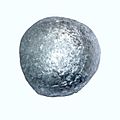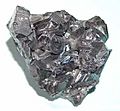Group 12 element facts for kids
A group 12 element is a special collection of chemical elements found in the periodic table. Think of the periodic table as a big chart that organizes all known elements. Elements in the same "group" (which are the vertical columns) often share similar features and behaviors.
The elements in Group 12 are zinc, cadmium, mercury, and copernicium. These elements have some interesting things in common. For example, they all have low melting and boiling points. This means they don't need a lot of heat to turn from a solid into a liquid or from a liquid into a gas. Mercury is so special that it's actually a liquid at room temperature!
Copernicium is a very new and super-heavy element. It's also very unstable, meaning it breaks apart quickly. Because of this, scientists don't know much about its exact properties yet.
Zinc is the most active element in this group. It reacts more easily with other substances compared to cadmium or mercury.
| Periodic table | |||||||||||||||||||||||||||||||||||||||||
|---|---|---|---|---|---|---|---|---|---|---|---|---|---|---|---|---|---|---|---|---|---|---|---|---|---|---|---|---|---|---|---|---|---|---|---|---|---|---|---|---|---|
| H | He | ||||||||||||||||||||||||||||||||||||||||
| Li | Be | B | C | N | O | F | Ne | ||||||||||||||||||||||||||||||||||
| Na | Mg | Al | Si | P | S | Cl | Ar | ||||||||||||||||||||||||||||||||||
| K | Ca | Sc | Ti | V | Cr | Mn | Fe | Co | Ni | Cu | Zn | Ga | Ge | As | Se | Br | Kr | ||||||||||||||||||||||||
| Rb | Sr | Y | Zr | Nb | Mo | Tc | Ru | Rh | Pd | Ag | Cd | In | Sn | Sb | Te | I | Xe | ||||||||||||||||||||||||
| Cs | Ba | La | Ce | Pr | Nd | Pm | Sm | Eu | Gd | Tb | Dy | Ho | Er | Tm | Yb | Lu | Hf | Ta | W | Re | Os | Ir | Pt | Au | Hg | Tl | Pb | Bi | Po | At | Rn | ||||||||||
| Fr | Ra | Ac | Th | Pa | U | Np | Pu | Am | Cm | Bk | Cf | Es | Fm | Md | No | Lr | Rf | Db | Sg | Bh | Hs | Mt | Ds | Rg | Cn | Uut | Fl | Uup | Lv | Uus | Uuo | ||||||||||
|
|||||||||||||||||||||||||||||||||||||||||
Contents
What Are Group 12 Elements?
Group 12 elements are part of the larger family of transition metals. Transition metals are known for being strong, shiny, and good at conducting heat and electricity. While Group 12 elements share some of these traits, they also have unique characteristics that set them apart.
Meet the Elements
Let's take a closer look at each element in Group 12:
Zinc
Zinc is a bluish-white, shiny metal. It's very important for human health and is found in many foods. Zinc is also used a lot in industry. For example, it's used to coat steel to stop it from rusting. This process is called galvanizing. Zinc is also a key part of brass, an alloy (mixture of metals) used to make musical instruments and decorations.
Cadmium
Cadmium is a soft, silvery-white metal. It's not as common as zinc. Cadmium used to be widely used in batteries and as a pigment (color) in paints. However, scientists found that cadmium can be harmful to people and the environment. Because of this, its use has been greatly reduced in many products today.
Mercury
Mercury is truly unique because it's the only metal that is a liquid at room temperature. It's a silvery, heavy liquid. Mercury was once used in thermometers and barometers. Like cadmium, mercury can also be harmful. So, its use has been limited, and safer alternatives are now preferred.
Copernicium
Copernicium (Cn) is a synthetic element, meaning it's made in a lab and not found naturally on Earth. It's extremely radioactive and unstable. This means it exists for only a tiny fraction of a second before breaking down. Scientists are still studying copernicium to understand its properties, but it's very challenging due to its short lifespan.
Properties of Group 12 Elements
Group 12 elements share some general properties, but also have differences.
Melting and Boiling Points
One of the most notable features of Group 12 elements is their relatively low melting and boiling points compared to other metals. This is why mercury is a liquid at normal temperatures. Zinc melts at 419.5 °C (787.1 °F), and cadmium melts at 321.1 °C (610.0 °F). These temperatures are much lower than, say, iron, which melts at 1,538 °C (2,800 °F).
Reactivity
When we talk about "reactivity," we mean how easily an element combines with other elements. Zinc is the most reactive element in Group 12. It can react with acids and bases. Cadmium is less reactive than zinc, and mercury is even less reactive. This low reactivity is why mercury was useful in some older scientific instruments.
Uses of Group 12 Elements
These elements, especially zinc, have many important uses in our daily lives and in industry.
Zinc's Many Uses
Zinc is incredibly versatile.
- Galvanizing: Protecting steel from rust is one of its biggest jobs.
- Alloys: It's mixed with copper to make brass, which is used for musical instruments, plumbing, and decorative items.
- Batteries: Zinc is used in many types of batteries, including alkaline batteries.
- Health: Zinc is an essential nutrient for humans, helping our immune system and growth.
Cadmium's Past and Present Uses
While its use has decreased, cadmium still has some specific applications:
- Nickel-cadmium batteries: These rechargeable batteries were once very common.
- Pigments: It was used to make bright yellow, orange, and red colors in paints and plastics.
- Control rods: In nuclear reactors, cadmium can be used to absorb neutrons and control the reaction.
Mercury's Historical and Limited Uses
Mercury's unique liquid state made it useful for a long time:
- Thermometers: Its ability to expand and contract evenly with temperature changes made it perfect for measuring heat.
- Barometers: Used to measure atmospheric pressure.
- Dental fillings: Amalgams (mixtures) containing mercury were used for tooth fillings.
Today, due to safety concerns, mercury is largely replaced by safer alternatives in these applications.
Images for kids
-
Sphalerite (ZnS), an important zinc ore
See also
 In Spanish: Elementos del grupo 12 para niños
In Spanish: Elementos del grupo 12 para niños





